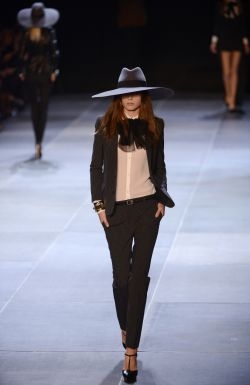Fashion merry-go-round brings Paris new faces for 2013

What better way to whet the appetite of fashionistas and keep sales ticking over?
“There comes a point when a brand needs to renew itself,” said Serge Carreira, a luxury industry expert and professor at Sciences Po university.
Change can come about involuntarily — as in the case of John Galliano, sacked by Dior over a racist outburst in February 2011 and succeeded last spring by the Belgian minimalist Raf Simons.
Or it can be deliberate, as at Yves Saint Laurent and Balenciaga, where Hedi Slimane and Alexander Wang were named to replace the outgoing designers Stefano Pilato and Nicolas Ghesquiere respectively.
“Taking on a new designer has become the new way for brands to whip up consumer appetite,” said luxury industry consultant Jean-Jacques Picart.
For the fashion world, this much change in one year spells the end of a cycle and the start of a new one, as seen in the early 2000s with the arrival of Slimane at Dior Homme, and Tom Ford at Saint Laurent, Picart said.
Ghesquiere spent 15 years at Balenciaga, as did Galliano at Dior, while Pilati was at YSL for 12 years in total, starting under Ford, said Pamela Golbin, curator at the Paris museum of decorative arts.
Long enough for the industry to change, and the job of designer too.
“The number of collections has gone from four to eight, 12 or more if you include capsule collections,” she said.
Brands increasingly look to designers to act as their public face, opening stores and attending galas.
— ‘Couturiers have to sell clothes’ —
Golbin captures the outlook in today’s fashion industry with a quote from the late French designer Madeleine Vionnet:
“‘Artists are here to make us dream — couturiers have to sell clothes, or they go out of business.'”
“Today it’s no longer enough to be able to design a dress,” Carreira said. “Having a strong identity and a distinctive product are the keys to success.”
At a time when luxury houses are looking to shore up their prospects for future growth, they need to strike a balancing act between creativity and business imperatives.
“And history tells us that it pays to be bold,” Carreira said. “If you ask talented creatives to produce standardised products, there is no reason it should work.”
Consumers have changed, too, in the past 15 years.
The industry is now addressing switched-on customers who are far from the fashion novices of the 1990s. Today’s clients go back and forth between big and niche brands and more or less expensive offerings.
This spring will bring what is widely awaited as Slimane’s first “real” shows for Yves Saint Laurent, after last October’s spring-summer collection by the cult designer seen as a homage to the house’s late founder.
Dior’s new designer Simons has already made a mark in Paris with two collections, one couture and one ready-to-wear, that reworked the house’s iconic nipped-waist silhouette with a clean-lined, contemporary twist.
And Wang, the darling of the New York fashion scene, will be taking his first steps at Balenciaga at the autumn-winter ready-to-wear shows this spring.
At 28, Wang is already a seasoned businessman, at the helm of an own-name fashion house that has been pushing into Asia, where the Taiwanese-American designer has his family roots.
His arrival at Balenciaga may or may not herald a more aggressive market strategy, but whatever direction the house takes, for Picart, Wang’s appointment “seals the arrival of a new generation” of designers at the high table of fashion — in the style capital of the world.

